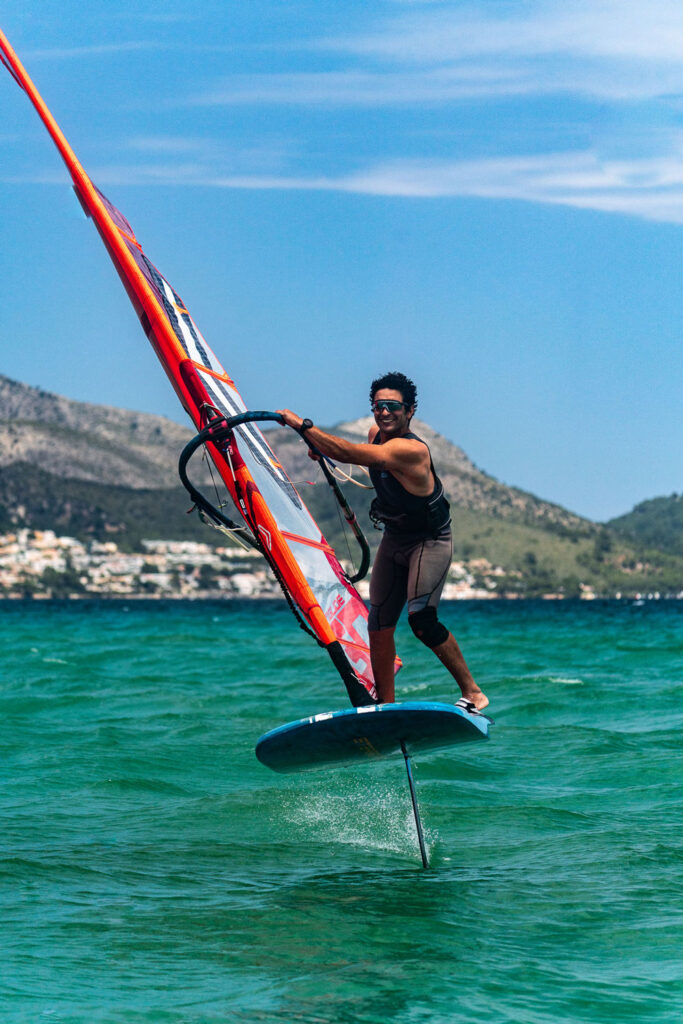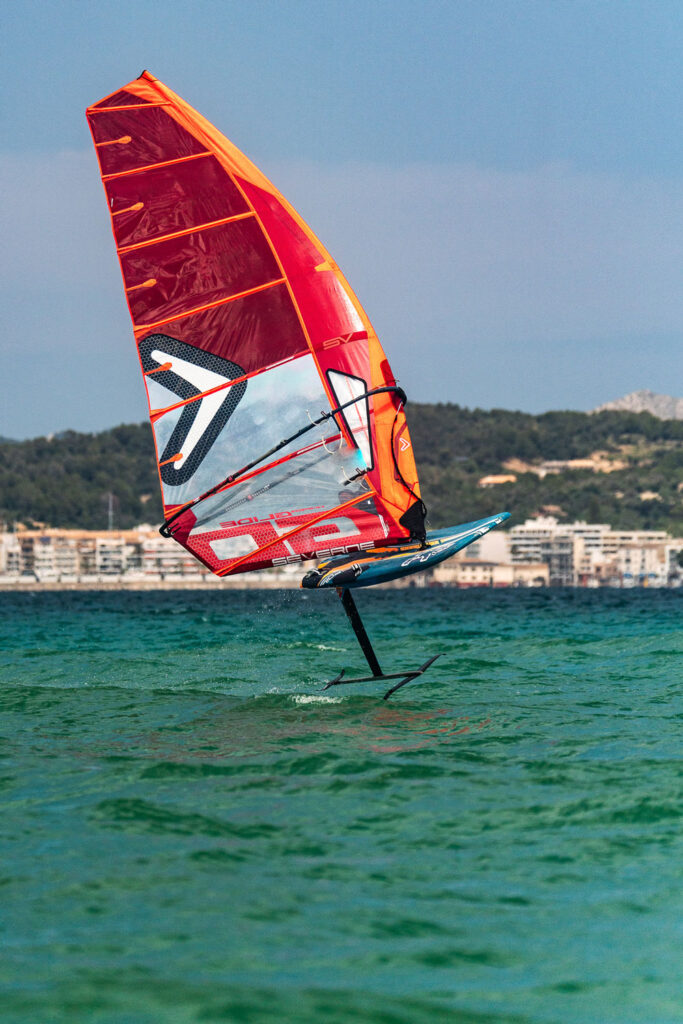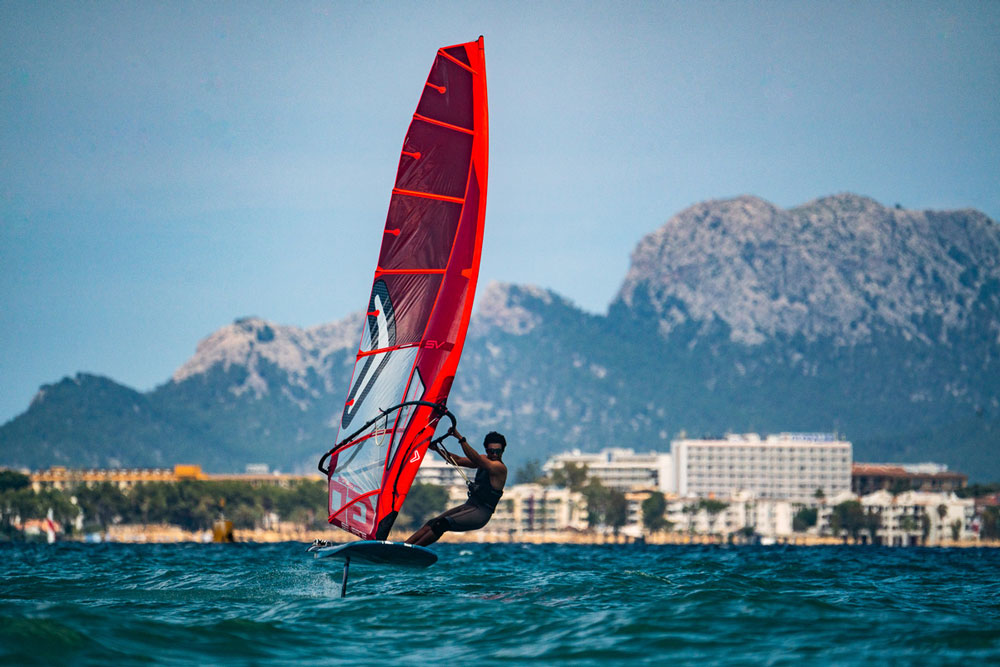A new dimension of windsurfing
Foil windsurfing, also known as wind foiling, has revolutionized the world of windsurfing. Thanks to a hydrofoil installed under the board, it is possible to “fly” over the water, reducing friction with the waves and gaining speed, fluidity and sensations. In Playa de Muro, one of Mallorca’s best beaches for water sports, the Water Sports Mallorca team has integrated this modality into its sailing school, offering a unique experience for both beginners and advanced riders.
A little history of traditional foil windsurfing
Windsurfing began in the 1960s as a natural evolution of surfing and dinghy sailing, and has since gone through various stages: from its Olympic boom in the 1980s to the emergence of freestyle, slalom, and wave surfing in the 2000s. However, in recent years, foil windsurfing has revolutionized the sport, not only technically but also emotionally: it has given many riders the desire to ride even in light winds.
The first foil applied to windsurfing emerged as an experiment, using hydrofoil technology already seen in sailing and kitesurfing. For years it was a minority concept, difficult to master and very technical. But the development of new materials (such as carbon, which is lighter and stiffer) and the design of more stable and accessible foils have allowed this sport to become more democratic.
Starting in 2016, windfoiling began to be part of international competitions, and in 2019, it was announced that it would partially replace traditional windsurfing at the 2024 Paris Olympic Games with the iQFoil class. This decision accelerated its expansion and made it one of the most innovative and fastest-growing modalities.
In Mallorca, and especially in Playa de Muro, foiling found its natural place: the combination of constant thermal winds, flat water, and safe conditions make it an ideal place for both beginners and advanced training.
What equipment is needed to windfoil?
- Foil windsurf board: shorter and wider than a traditional board, with reinforcements to withstand the pressure of the foil.
- Foil: the heart of the system. It typically consists of a mast, fuselage, and wings (front and rear). Common materials used to construct foils include carbon, aluminum, and fiberglass.
- Sails: smaller sails are typically used than in conventional windsurfing, as foils allow for planning in less wind.
- Wetsuit and life jacket: essential for safety, especially in spring or fall, when the water is colder.
Playa de Muro: Mallorcan Windfoil Paradise
Located in the north of Mallorca, Playa de Muro offers crystal-clear waters, sandy bottoms, and constant thermal winds during the spring and summer months. These conditions make it the ideal place to start or improve your windfoiling skills.
Advantages of Playa de Muro for windfoiling
- Gentle thermal winds ideal for learning.
- Plenty of space to sail without crowds.
- Safety: no strong currents or large waves.
- Direct access to the water from the Watersports Mallorca school.
Techniques and learning: how to learn to fly?
Foil windsurfing is a discipline that completely transforms the windsurfing experience. Unlike traditional windsurfing, you don’t ride on the water, but rather above it, taking off from 10-12 knots of wind thanks to the lift generated by the foil. This change in dynamics requires a new technique, but also opens up a range of new and addictive sensations.
Although some prior windsurfing experience is recommended (at least knowing how to tack, gybe, and wind safely), it’s not essential to be an expert to start foiling. In fact, with the right conditions and good support, the learning curve can be faster than it seems.

Learning Phases:
- Equipment Control on Land.
Before hitting the water, it’s important to familiarize yourself with the equipment: how to set up the foil, understand its components (mast, fuselage, front and rear wings), and know how to transport and care for it. Foils are delicate and require attention both during setup and handling out of the water.
- First Tacks Without Lifting the Foil.
In this phase, you ride like traditional windsurfing, but with the foil mounted. The goal is to get used to the different volume of the board and the greater draft (depth) that the foil provides. It’s important to maintain a balanced position, avoid sudden movements, and take your time to fly. This is where stability, posture, and steering control are trained.
- First Controlled Flights.
When sufficient speed is reached, the foil begins to generate lift and the board rises from the water. This moment requires good body control:
- Keep the pressure balanced between both feet (more weight back to take off, more forward to avoid rising too much).
- Always keep your eyes on the horizon.
- Avoid sudden movements of the sail.
- Keep your body centered and relaxed.
- Control your height and speed.
Once you’ve managed to stay in the air, the next step is learning how to regulate the height of the foil (so as not to fly too high or constantly touch the water) and how to modulate your speed. This is achieved with small adjustments to your posture, body angle, and foot pressure.
- Foil maneuvers.
Mastering foil tacks and gybes requires more skill. The difficulty lies in maintaining glide during the maneuver without the foil touching the water or getting out of control. You start by first touching the water during the maneuver and gradually complete “full foiling turns,” that is, complete turns while flying.
Methodology at Watersports Mallorca
At Watersports Mallorca, instructors adapt classes to each student’s level. The approach is very practical and progressive:
- Small groups or private lessons.
- Equipment adapted to each stage: larger, more stable boards for beginners, low-profile foils, and light sails.
- Safe, shallow areas near the beach for the first few days.
- Constant feedback and video recordings are provided to improve technique.
In addition, Playa de Muro offers ideal conditions: gentle winds, flat water, and no currents, allowing for learning in a stress-free and completely safe environment.

Tips for beginner riders
Getting started with foil windsurfing can seem intimidating at first, but with a good windsurfing foundation and the right environment, it becomes a very rewarding and accessible experience. Here are some practical tips to make your first flights safe and fun:
Before you get on the water
- Know your equipment: Understand how the foil is mounted, how it’s adjusted, and how each component affects your ride (especially mast length and wing size).
- Choose your day wisely: Start with a light, steady wind (ideally between 10 and 15 knots), and avoid swell or gusty conditions.
- Wear appropriate protection: A lightweight helmet and impact vest are recommended at first. A thin wetsuit will also protect you from potential foil impacts.
During the ride
- Relaxed and centered posture: Keep your body aligned with the board and avoid sudden movements. If you feel the foil rising too much, lean slightly forward.
- Start sailing in a straight line: don’t try to tack or gybe until you feel comfortable flying on both sides.
- Don’t look at the foil: focus your gaze on the horizon, this will help you maintain balance and anticipate changes in wind or sea.
- Don’t force the takeoff: if the foil doesn’t lift, it’s better to keep practicing your balance and wait for your technique or the wind to allow it.
Common Mistakes and How to Avoid Them
- Putting your weight back after takeoff: This causes the foil to rise too much and can destabilize it.
- Putting too much pressure on your back foot: Learn to adjust gradually to maintain a constant height without jumping.
- Trying to move too quickly: Enjoy the process; every phase is important and fun.
At Watersports Mallorca, you’ll have specialized instructors who will quickly spot your mistakes and help you correct them. You can also try different foil, board, and sail configurations until you find the one that best suits your style.
Recommended brands for windfoil
When choosing foil windsurfing equipment, quality is key to ensuring a good riding experience, safety, and progression. At Watersports Mallorca, we work with leading brands that offer reliability, innovation, and durability.
Sails:
- Duotone: a benchmark in design and performance. Its foil-specific sails are light and maneuverable.
- Severne: ideal for riders looking for precision and control. It offers models specifically for freeride and slalom foiling.
- NeilPryde: a more classic windsurfing brand that has adapted perfectly to the foil world, with stable and powerful sails.
Boards:
- Fanatic: very popular in schools for their balance of stability and maneuverability. Models like the “Falcon Foil” are designed for all stages of learning.
- Starboard: innovative and versatile, with models ranging from freeride to competition.
- JP Australia: highly rated for their lightness and robust construction. Excellent for intermediate and advanced riders.
Foils:
- Slingshot: Modular foils, easy to assemble and customize. Widely used in schools and among beginners.
- F4 Foils: High-end, designed for competition and maximum performance. Cutting-edge technology.
- Naish: A balanced option between stability and performance, ideal for freeriders.
You don’t need the most expensive equipment to enjoy windfoiling. The most important thing is that it suits your level and style. At Watersports Mallorca, you can try out different equipment before making a decision.
The future of windfoil in Mallorca
With its growing popularity, more and more schools are incorporating windfoiling into their offerings. Watersports Mallorca combines passion, experience, and a privileged environment. Wind foiling is also an excellent gateway to other disciplines such as wing foiling or kite foiling.





